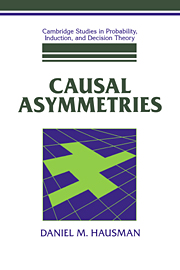Book contents
- Frontmatter
- Contents
- List of Figures
- Acknowledgments
- Introduction: Causation and its Asymmetries
- 1 Metaphysical Pictures and Wishes
- 1* Transfer Theories
- 2 Is Causation a Relation Among Events?
- 3 Causation, Regularities, and Time: Hume's Theory
- 4 Causation and Independence
- 4* Causation, Independence, and Causal Connection
- 5 Agency Theory
- 5* Causal Generalizations and Agency
- 6 The Counterfactual Theory
- 6* Independence and Counterfactual Dependence
- 7 Counterfactuals, Agency, and Independence
- 7* Agency, Counterfactuals, and Independence
- 8 Causation, Explanation, and Laws
- 8* Causation, Explanation, and Independent Alterability
- 9 Probabilistic Causation
- 10 Causation and Conditional Probabilities
- 10* Causal Graphs and Conditional Probabilistic Dependencies
- 11 Intervention, Robustness, and Probabilistic Dependence
- 11* Interventions and Conditional Probabilities
- 12 Operationalizing and Revising the Independence Theory
- 12* Probability Distributions and Causation
- 13 Complications and Conclusions
- Appendix A Alphabetical List of Propositions
- Appendix B List of Theorems
- References
- Index
3 - Causation, Regularities, and Time: Hume's Theory
Published online by Cambridge University Press: 20 April 2010
- Frontmatter
- Contents
- List of Figures
- Acknowledgments
- Introduction: Causation and its Asymmetries
- 1 Metaphysical Pictures and Wishes
- 1* Transfer Theories
- 2 Is Causation a Relation Among Events?
- 3 Causation, Regularities, and Time: Hume's Theory
- 4 Causation and Independence
- 4* Causation, Independence, and Causal Connection
- 5 Agency Theory
- 5* Causal Generalizations and Agency
- 6 The Counterfactual Theory
- 6* Independence and Counterfactual Dependence
- 7 Counterfactuals, Agency, and Independence
- 7* Agency, Counterfactuals, and Independence
- 8 Causation, Explanation, and Laws
- 8* Causation, Explanation, and Independent Alterability
- 9 Probabilistic Causation
- 10 Causation and Conditional Probabilities
- 10* Causal Graphs and Conditional Probabilistic Dependencies
- 11 Intervention, Robustness, and Probabilistic Dependence
- 11* Interventions and Conditional Probabilities
- 12 Operationalizing and Revising the Independence Theory
- 12* Probability Distributions and Causation
- 13 Complications and Conclusions
- Appendix A Alphabetical List of Propositions
- Appendix B List of Theorems
- References
- Index
Summary
It is fitting for both historical and philosophical reasons to begin the discussion of causation with David Hume's theory and its contemporary developments. Hume's theory is the starting point for most modern treatments of causation, and the problems his theory must surmount are problems for all theories of causation. Some philosophers believe that Hume was right, though they would add that his account of causation needs refinement. Others, including me, would reject Hume's theory. Nevertheless, my views owe a great deal to Hume.
Hume's Theory
Hume argues that causation involves a regular association between cause and effect with the cause contiguous with its immediate effects and preceding them. He also argues that the human psychological propensity to pass from an “impression” (perception) of a cause to an idea of its effects (or from an impression of an effect to an idea of its cause) leads people mistakenly to believe that there is a necessary connection between cause and effect. This account takes the mystery out of causation, while retaining the all-important links between causation and regularities and explaining the mistaken belief that there is more to causation than regularity, contiguity, and time order.
Hume claims to clarify the content of our “ideas” (mental contents) and of the relations among them, and he does not clearly demarcate philosophy from introspective psychology. His account of causation is constrained by his empiricism – that is, his view that all our ideas derive from preceding impressions of sense or reflection. He is saying that nonlogical terms have meaning only if one can tell by observation whether they apply to things and that the evidence for all claims concerning matters of fact derives from observation.
- Type
- Chapter
- Information
- Causal Asymmetries , pp. 36 - 54Publisher: Cambridge University PressPrint publication year: 1998

